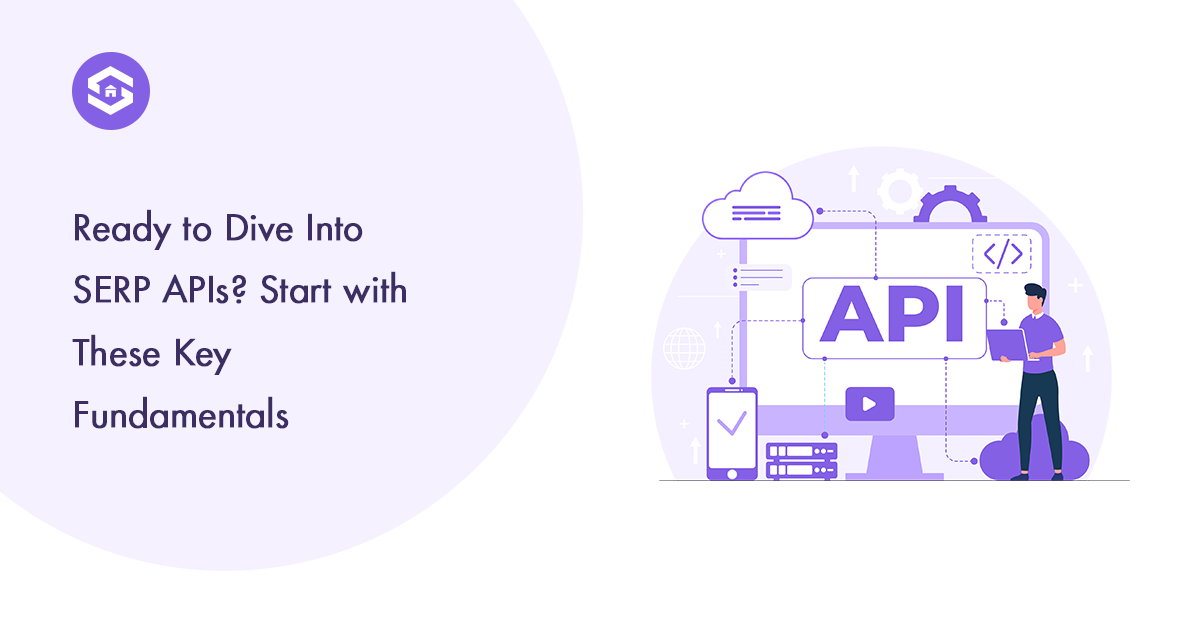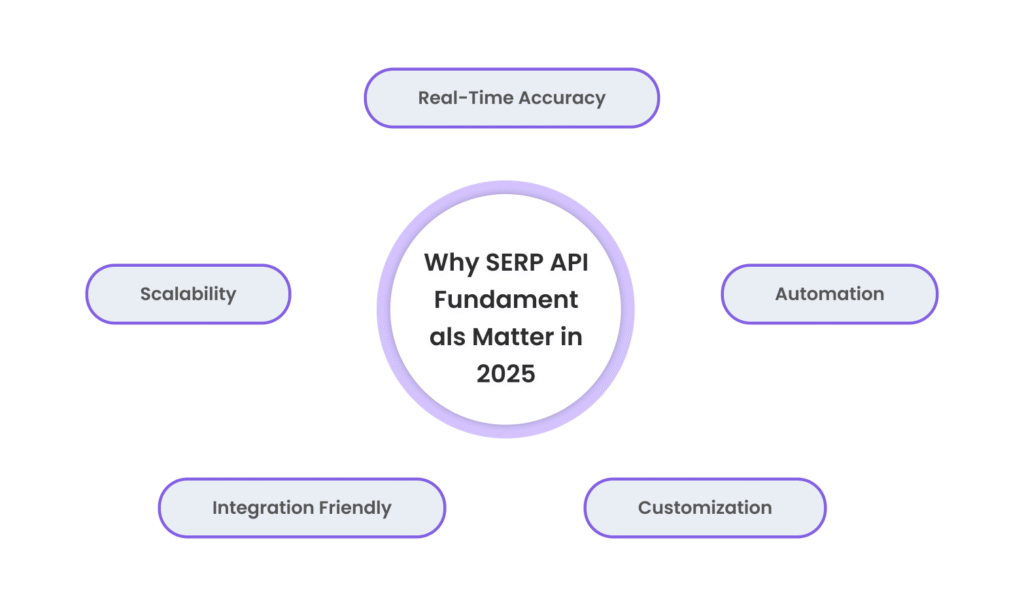SERP API Fundamentals Explained: What You Really Need to Know
11 min read
11 min read

Table of Contents
Table of Contents
You know when an SEO tool shows you exactly where your website ranks, which keywords are gaining traction, or how your competitors are performing—all within seconds? It feels almost instant, but there’s no magic behind it. It all comes down to grasping the SERP API fundamentals. These powerful APIs quietly run in the background, pulling real-time data straight from search engines so businesses can track rankings, uncover trends, and make faster, smarter decisions without ever refreshing a browser tab.
In the age of real-time data and digital-first marketing, accessing search engine results pages (SERPs) manually is not just slow — it’s practically impossible at scale. That’s where SERP APIs come in. They give developers, marketers, and data analysts direct access to search engine results in a structured, fast, and automated way.
But what exactly is a SERP API? How does it work? And more importantly, how can you leverage it smartly?
In this blog, we’ll break down the SERP API fundamentals so thoroughly that by the end, you’ll know everything you really need — from how SERP APIs function to the crucial features to look for when choosing one.
A SERP API (Search Engine Results Page Application Programming Interface) is a service that allows you to retrieve real-time search results from a search engine like Google, Bing, Yahoo, or others — in a structured, machine-readable format such as JSON or HTML.
Rather than manually searching for a keyword and copying the results, a SERP API automates the entire process. You send a request (for example, a query like “best smartphones 2025”), and the API returns all the search results you would see on a live SERP — often including organic listings, ads, featured snippets, map packs, videos, and more.
In short: You ask the API a question. It gives you the search engine’s answer, in data form.

Search engine results change constantly. Rankings fluctuate by the hour. Competitors test new strategies daily. And users demand fast answers.
In this volatile landscape, waiting on manual updates or relying on out-of-date tools is a risk most businesses can’t afford.
In a data-driven world, SERP APIs are not optional. They’re essential.
Understanding how SERP APIs work under the hood gives you a clearer picture of their power. Here’s a simplified breakdown of the process:
1. You Send a Query Request
You specify what you want: a keyword, language, location, search type (web, image, news), number of results, etc. This is sent as a GET or POST request to the API.
2. The API Handles the Search Engine
The API provider sends that query to the live search engine (like Google), mimicking a human search. To avoid being blocked, the request typically goes through a network of rotating IP addresses and may even use headless browsers.
3. Results Are Fetched and Structured
The search engine returns the HTML content of the results page. The API provider then parses and cleans this HTML, extracting structured data — like titles, URLs, snippets, featured snippets, ads, etc.
4. The API Sends Back a Clean Response
You receive a structured JSON (or XML/HTML) response with clean, organized data ready for use in your app or tool.
This entire cycle usually happens in less than a second.
Not all SERP APIs are built the same. Some are bare-bones, while others are feature-rich and optimised for performance and scale. If you’re choosing a SERP API provider, these are the fundamental features you should evaluate:

While Google may be the most dominant, a good SERP API also supports Bing, Yahoo, DuckDuckGo, Yandex, Baidu, Naver, and others.
The ability to target SERPs from specific countries, cities, or even postal codes is critical for local SEO and international tracking.
You should be able to simulate searches from desktops, tablets, or mobile phones, and request results in multiple languages.
The API should provide data not only from organic results but also from:
Make sure your SERP API provider fetches real-time data, not cached or delayed results. Accuracy and freshness are critical when monitoring rank changes or tracking trends.
Scraping search engines is tricky. Good SERP APIs have robust proxy management, CAPTCHA solvers, and anti-detection mechanisms that ensure consistent uptime and zero blocks.
SERP APIs are used in far more ways than just rank tracking. Let’s explore how different industries, tools, and teams use this technology to drive smarter decisions and real-time insights.
This is the most common use case. Businesses with hundreds or thousands of keywords need to know where they rank — not once a month, but daily or even hourly. Manually checking keyword positions across multiple locations and devices is impossible at that scale.
SERP APIs automate this entire process. They provide real-time keyword rankings, allowing SEO teams to monitor their performance, detect sudden ranking drops, and assess how content updates impact visibility. What makes SERP APIs powerful here is not just automation, but location precision, device targeting, and SERP feature detection — letting teams measure visibility on map packs, featured snippets, and organic results separately.
You can’t build a winning SEO strategy without knowing what your competitors are doing. SERP APIs let marketers and analysts track their competitors’ presence across search engines. This includes monitoring which keywords competitors rank for, what type of content appears, how often they show up in ads or featured snippets, and how their rankings evolve.
With a SERP API, you can even build dashboards that visualize competitor shifts in real-time, helping you react faster and identify opportunities before they’re saturated.
Running paid ad campaigns? A SERP API helps ensure your ads are actually being displayed — and where. You can also monitor which competitors are bidding on your branded terms, how frequently their ads appear, what their headlines and ad extensions say, and whether they’re using discounts, urgency triggers, or location targeting.
This level of transparency is extremely valuable for improving your own ad copy, tracking ROI, and protecting your brand.
Today’s SERPs are not just ten blue links. They are dynamic, filled with People Also Ask, Knowledge Panels, Top Stories, Videos, FAQs, and more. For digital marketers and content strategists, knowing how often and where these features appear is crucial for content planning.
SERP APIs give granular insight into which SERP features appear for specific queries, whether they’re dominated by competitors, and how your own brand content fits into those blocks. This allows for better targeting of rich snippet opportunities and schema optimisation.
Local businesses need to know how they rank in their city — not globally. A SERP API with local result simulation allows users to emulate searches from any location. This means you can get SERP data as if you were searching from a particular street, city, or country.
For agencies managing multiple clients across different regions, this feature is gold. You can track local packs, Google Business listings, and even how local competitors are showing up in map results.
If your blog post drops from position #3 to #10, your traffic will suffer. SERP APIs help you spot such drops immediately. More importantly, by analysing the results above and below your listing, you can understand what kind of content Google prefers for that keyword.
This can guide your optimisation strategy — whether you need longer content, more visuals, a better title, or even structured data. SERP APIs help uncover these content gaps quickly and at scale.
When people talk about scraping search engines, most focus only on the first page of results. But the truth is, that valuable insights often live beyond the top 10 listings. This is where pagination and result depth come in — two of the most underappreciated fundamentals of SERP APIs.
Let’s say you’re tracking a keyword like “best budget laptops 2025.” Your website used to rank on page 1 but has now slipped to page 3. Without pagination support, a SERP API will only show you page 1, making it seem like your site has vanished. This leads to false negatives and poor analysis.
With pagination support, you can crawl results from pages 1 to 5 or more, tracking deeper visibility and analysing long-tail positioning that still brings in meaningful traffic.
Most SERP APIs let you specify how many results you want (e.g., top 10, 20, 50, 100). This is called result depth. A deeper result depth allows you to:
If you’re conducting in-depth audits, building large datasets, or training AI models on search data, deep pagination and high result depth are critical features your SERP API must offer.
Not all SERP APIs give you real-time data. Some providers use cached responses, meaning they store the SERP for a given query and re-serve it for the next few hours to reduce costs.
While this might be fine for static or infrequent searches, it’s a serious limitation for high-frequency use cases like:
If freshness matters, always choose a SERP API that explicitly guarantees real-time results with options to bypass caching when necessary. The small increase in cost is worth it for accurate, live data.
If you’re selecting a SERP API provider, don’t just look at pricing or popularity. You need to evaluate based on your specific requirements. Here’s a deeper look into the must-consider factors:
You don’t want your SERP tracking to break when you need it most. A reliable provider should offer 99.9% uptime, robust monitoring, and strong technical infrastructure. Look for one that operates across global data centres.
As your needs grow, can the API keep up? Check whether the provider offers high request volumes, concurrent queries, and bulk search support. Also, evaluate if they support batch querying to reduce overhead.
Can you control location, device, language, and search engine type? Can you target featured snippets specifically? More flexibility means more actionable insights.
A great SERP API doesn’t just fetch data — it delivers clean, structured, and usable JSON that can be fed directly into your applications, visualisations, or pipelines without heavy post-processing.
When issues arise, you need responsive support and clear, detailed documentation. Look for providers with GitHub SDKs, code samples, quick-start guides, and robust community support.
The search landscape is evolving. AI-generated answers, multimodal search, and personalised SERPs are becoming the norm. But with this complexity comes a bigger need for visibility.
SERP APIs aren’t just tools. They’re data gateways — giving businesses the power to see, understand, and react to what search engines are showing their audience.
Whether you’re a marketer trying to win more traffic, a data scientist training a model, or a product team building an SEO tool — SERP APIs will remain at the core of your strategy.
However, not all APIs are built equal. Mastering the SERP API fundamentals — like pagination, real-time querying, SERP feature tracking, location precision, and anti-blocking infrastructure — ensures you’re making the right long-term investment.